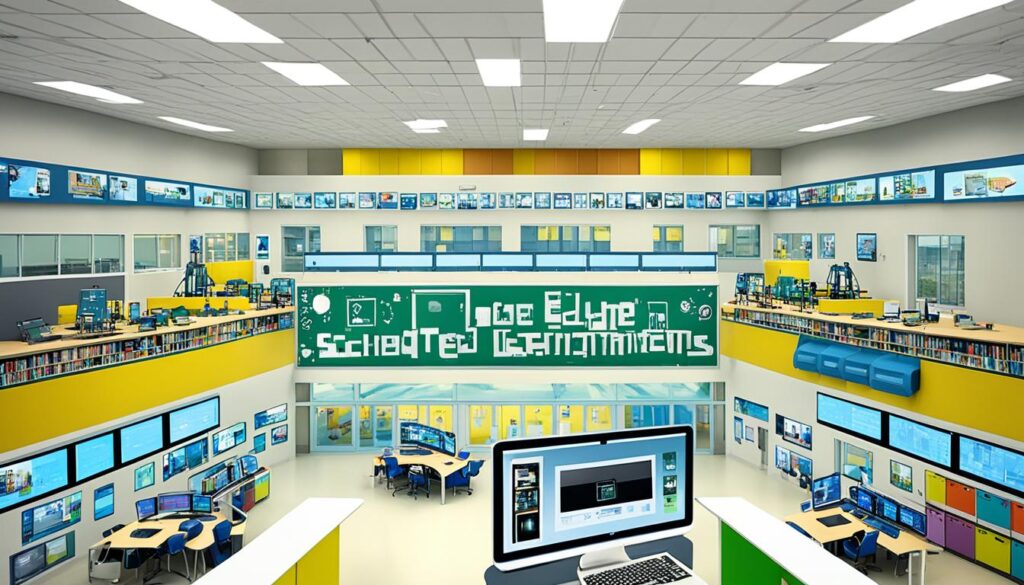Table of Contents
ToggleEducation System: Technology advances are changing how we teach and learn, making the old ways new. With our world getting more digital, the educational system in the United States must change too. It’s to make sure students get the right skills for the modern workplace. The COVID-19 crisis has pushed even harder for tech to be a big part of how we learn. This is shown by the shift to online and hybrid classes.
Using the latest in educational tech can make learning more fun, adjust to each student’s needs, and get them ready for future jobs. Yet, the real value of tech in learning isn’t just having it. It’s about teachers using it wisely to meet all students’ different needs. Bringing tech in should be about reaching goals, not just using tech.
Key Takeaways
- The COVID-19 pandemic has highlighted the importance of incorporating technology into the education system.
- Integrating educational technology can increase student engagement, improve lesson plans, and facilitate personalized learning.
- Technology is a tool in education, not an end in itself, and its success depends on how educators use it to support students’ needs.
- Educators must strike a balance between traditional teaching methods and innovative digital learning strategies to create a comprehensive and effective educational experience.
- The effective use of educational technology can help students develop the necessary 21st-century skills to thrive in the evolving job market.
Technology’s Impact on Education
The fast growth of technology has changed the US education scene. It’s given more access to study materials. It’s created new chances for people to communicate and work together. This shift has made teaching and learning more student-focused. It’s preparing students better for jobs today.
Expanded Access to Education
Education used to be just for a lucky few. But, the internet and digital tools have changed that. Now, lots of information and classes are online for everyone. Sites like Khan Academy and MOOCs have made college courses free and online. This lets people from all walks of life learn and get degrees from home.
New Opportunities for Communication and Collaboration
Technology also helps students talk and work together in new ways. They can reach out to experts, talk about what they’re learning, and do projects with people from far away. Things like online chatrooms, video calls, and special software have made learning more fun and real. They’re getting ready for jobs that need global teamwork and understanding.
Shifting Roles of Teachers and Learners
Using tech in class has changed how teachers and students work. Teachers now are more like helpers, guiding learning steps. But, students do most of the learning themselves. They can find a lot of info and tools easily. This lets them explore and think deeply about what they’re learning.
As education tech grows, its effect will be even stronger. Embracing these changes helps teachers create better, more personal learning spaces. This helps students gain the right skills and understanding they need today.
Also Read : 10 Proven Strategies For Acing Defence Exams!
Scaling Up Quality Instruction

The education system in the United States is working hard to reach all students with top-notch teaching. Especially in places where schools struggle to find enough teachers. But, new tech trends are giving valuable options to improve this and spread good teaching methods.
Technology steps in by making it easier to share the wisdom of great teachers with more students. In places finding it tough to hire or keep good teachers, tech helps share lessons from pros. This way, not only all students get to learn from the best, but superb teachers can impact more learners.
Also, tech is making it possible for students in faraway or under-resourced areas to access education. Tools like video calls, ready-to-use learning materials, and other digital resources connect students with skilled educators without needing to be close by.
Even though the results of this teaching approach are not fully clear, the chance to extend the reach of great teachers is exciting. As the education system moves forward, bringing tech into classes strategically can help all students get top-notch educational opportunities. This is no matter where they are or how much their school can offer.
| Challenges Addressed | Technological Solutions |
|---|---|
| Difficulty in recruiting and retaining qualified teachers in underserved areas | Dissemination of pre-recorded lessons by subject matter experts |
| Limited access to educational opportunities in remote or underserved communities | Technology-enabled distance education solutions |
“The strategic integration of technology in the classroom can help to ensure that all students, regardless of their location or the resources of their school, have access to high-quality educational experiences.”
Also Read : Unlock Opportunities With PSU Exams Jobs
Facilitating Differentiated Instruction

The education system in the USA works to meet every student’s needs. It uses technology to tailor teaching to each student. This makes learning more personal and effective for everyone.
Computer-Adaptive Learning
Computer-adaptive learning changes with each student. It tracks how each student does and alters the lessons. This helps students learn at their own pace and level, making sure they’re always challenged.
One-on-One Tutoring
Yet, having a teacher or tutor all to yourself is vital. One-on-one tutoring offers personal attention. It helps with your specific needs, whether you’re struggling or wanting to learn more. This method is great for anyone needing a bit more support.
Blending technology’s power with teachers’ skills makes a big difference. It ensures that all students get the support they need. It’s about giving each person a chance to reach their full potential.
Also Read : CTET Conqueror’s Handbook: Your Key To Educational Success!
Expanding Opportunities for Practice

Technology has changed how we learn, giving us new ways to practice and improve our skills. It offers a lot of educational resources and activities that provide instant feedback. Because of this, students can learn complex ideas better and work on important skills.
Learning with technology means students can practice more and use what they learn in real life. They have access to digital tools and simulations which help them do experiments and get feedback right away. This extra practice is great for students who find some subjects hard or want to learn more. With personalized and adaptive exercises, technology can show students where they need help. It then gives additional support, customizing their learning experience.
Not only that, but educational apps, virtual labs, and interactive games also make learning fun. They use gamification, cool visuals, and instant feedback to keep students motivated. This encourages students to self-explore and learn at their own speed. As we move forward, technology is changing how students learn and understand new things. Educators can now make learning spaces that are unique to each student. This helps students take an active part in their learning journey.
“Technology has the power to transform the way students engage with and solidify their learning, opening up a world of possibilities for enhanced practice and mastery.”
Also Read : Land Your Dream Role With IIFT Exam Jobs
Increasing Learner Engagement
Technology is changing the way we learn, making it more interesting. It uses fun educational videos and games to keep students engaged. This helps them learn better by creating an active learning space.
Educational Videos
More and more, classes are using videos to teach. These videos grab student’s attention and explain hard topics clearly. They make learning fun and improve how well students remember what they learned.
Gamification
Add to videos, games are also helping students learn. Games add points, levels, and friendly competition. This makes learning more fun and exciting for students. It gives higher education system them a reason to do their best and feel good about their accomplishments.
This new way of teaching might change schools for the better. It can make learning more fun and interesting for students everywhere.
“Technology has the power to transform education, making it more interactive, dynamic, and tailored to individual learning styles.”
Education System: Assessing Needs and Readiness

Before schools buy Education technology, they must know what they need, and what associate degree they can handle. This is key to make sure the tech fits each school’s unique situation community colleges well. To figure this out, schools look at how students are doing, what tech they have, and if teachers can use more tech in class. Knowing these secondary school things helps schools pick the right tech tools that will truly make education better.
Assessing Current Capabilities
First, schools check their current abilities. They look at how students are doing, where degree program tech could help in teaching, and if teachers know how to use tech.
- Review how students do on tests to find where they need help.
- Check what tech, like computers and internet, the school has.
- See how comfortable teachers are with using tech for teaching.
Prioritizing Needs and Readiness
Once they’ve looked into everything, schools decide what they need most and if they’re ready for new tech. They do this by:
- Finding the main education challenges that can be fixed with tech.
- Seeing if they have what’s needed to use and keep up tech tools.
- Finding out if the teachers and leaders want to use more tech.
This careful look at needs and readiness helps schools choose the right tech. It should really help students learn better.
| Assessing Needs | Evaluating Readiness |
|---|---|
|
|
By being careful and thoughtful, schools can buy tech that makes a real difference. This way, the tech plan is smart, helps a lot, and continues to be useful.
“Investing in educational technology without first understanding the college or university specific needs and capabilities of a school system is like building a house without a solid foundation. The key is to start with a thorough assessment to lay the groundwork for successful implementation.”
Also Read : Top Civil Engineering Colleges In The USA 2024
Evidence-Based Approach to EdTech Implementation
The world of education in the United States is changing fast. Now, using educational technology (EdTech) well is very important. An approach based on solid evidence is key. It means first carefully looking at what schools need and the problems they face. Then, we choose the right technology to help.
From preschool to college, our system aims at giving students a full education. An evidence-based method for EdTech means these institutions can use technology better. It helps make teaching better, offers learning tailored for each student, and boosts student results.
This method includes doing deep research, gathering data, and checking how well EdTech works. It’s about making smart choices after studying the effects of different tech tools. Also, it’s important to keep checking and changing things as needed. This way, schools and universities can really use technology to help students succeed. They prepare them well for the jobs of the future.
Also Read: Education Degree Online: What Are The Admission Requirements?
FAQs
Q: What is the role of technology in enhancing the education system?
A: Technology plays a crucial role in enhancing the education system by providing innovative ways for students to learn, collaborate, and access information.
Q: How does technology benefit higher education institutions?
A: Technology benefits higher education institutions by offering online courses, virtual resources, and interactive tools that facilitate distance learning and research.
Q: How can students enroll in online education programs?
A: Students can enroll in online education programs by visiting the institution’s website, filling out an application form, and following the admissions process outlined by the university or college.
Q: What are the advantages of studying in the USA as an international student?
A: Studying in the USA as an international student offers diverse academic programs, networking opportunities, and cultural experiences that enhance one’s educational journey.
Q: What is the structure of the US education system?
A: The US education system is divided into primary, secondary, and higher education levels, with each level designed to provide students with a comprehensive learning experience.
Q: What is the significance of early childhood education in shaping a child’s future?
A: Early childhood education plays a crucial role in shaping a child’s future by providing a strong educational foundation, fostering social skills, and promoting cognitive development.
Q: Can technology improve the grading system in educational institutions?
A: Yes, technology can improve the grading system in educational institutions by automating grading processes, providing instant feedback to students, and enhancing overall efficiency.





